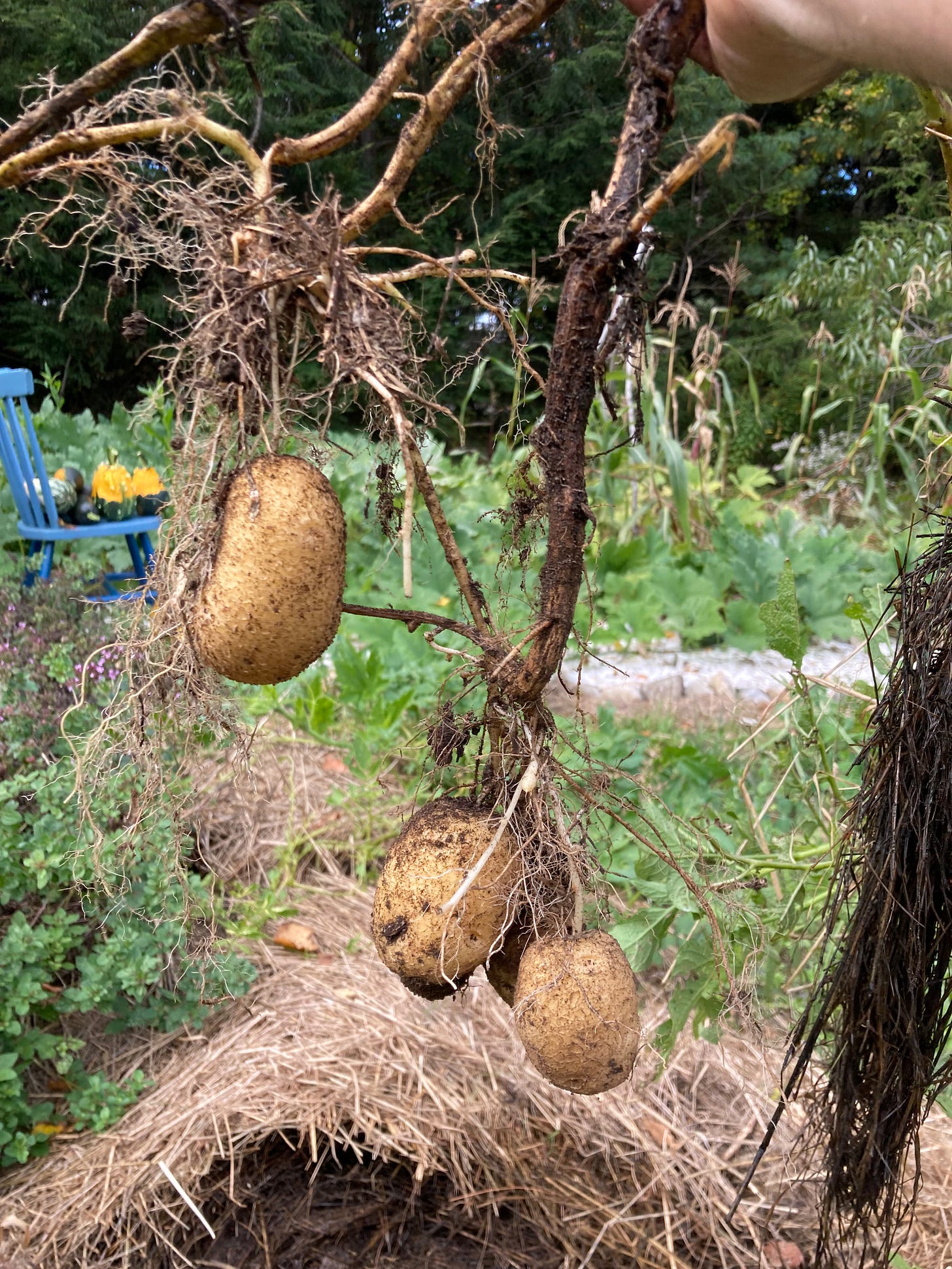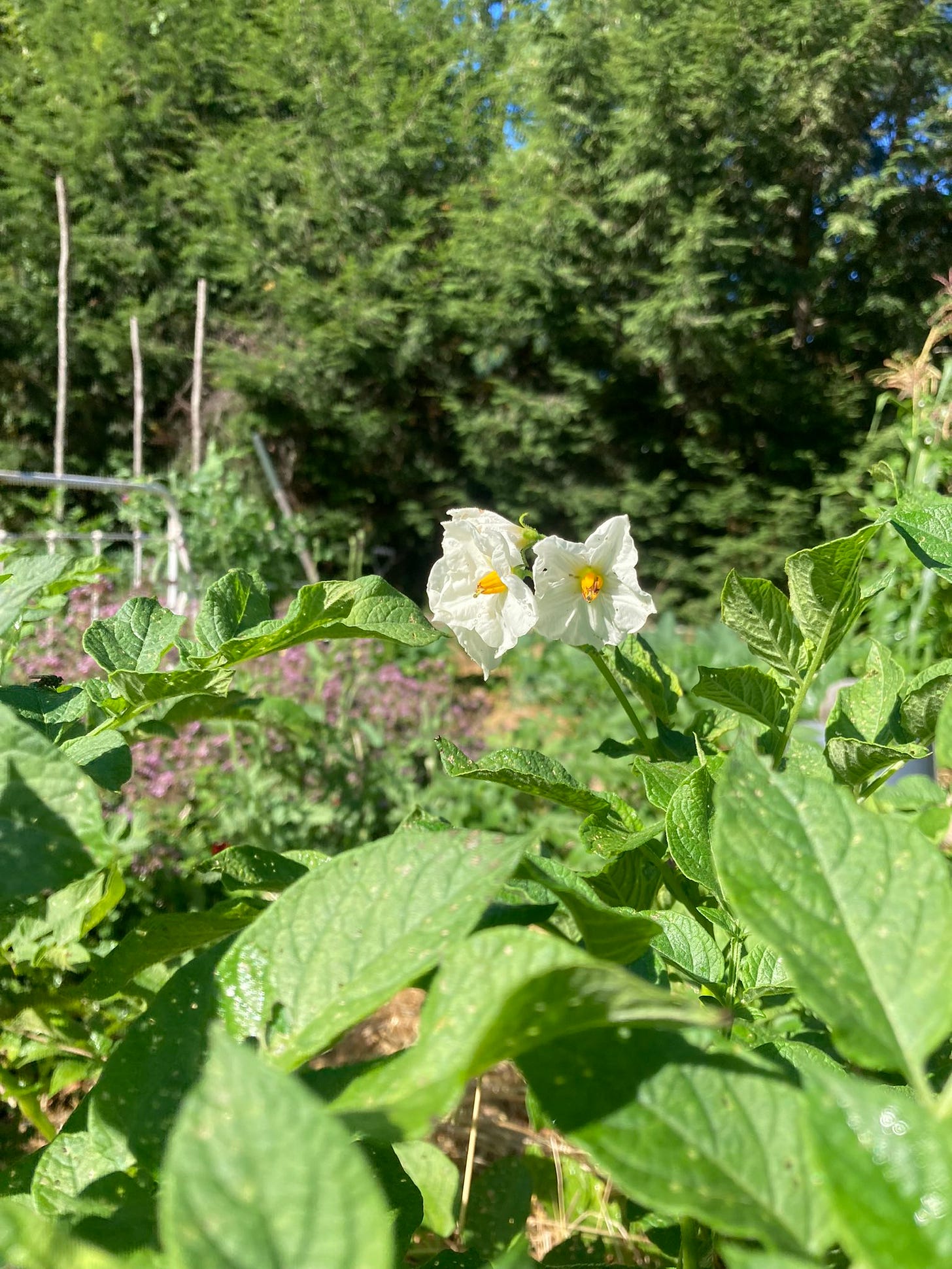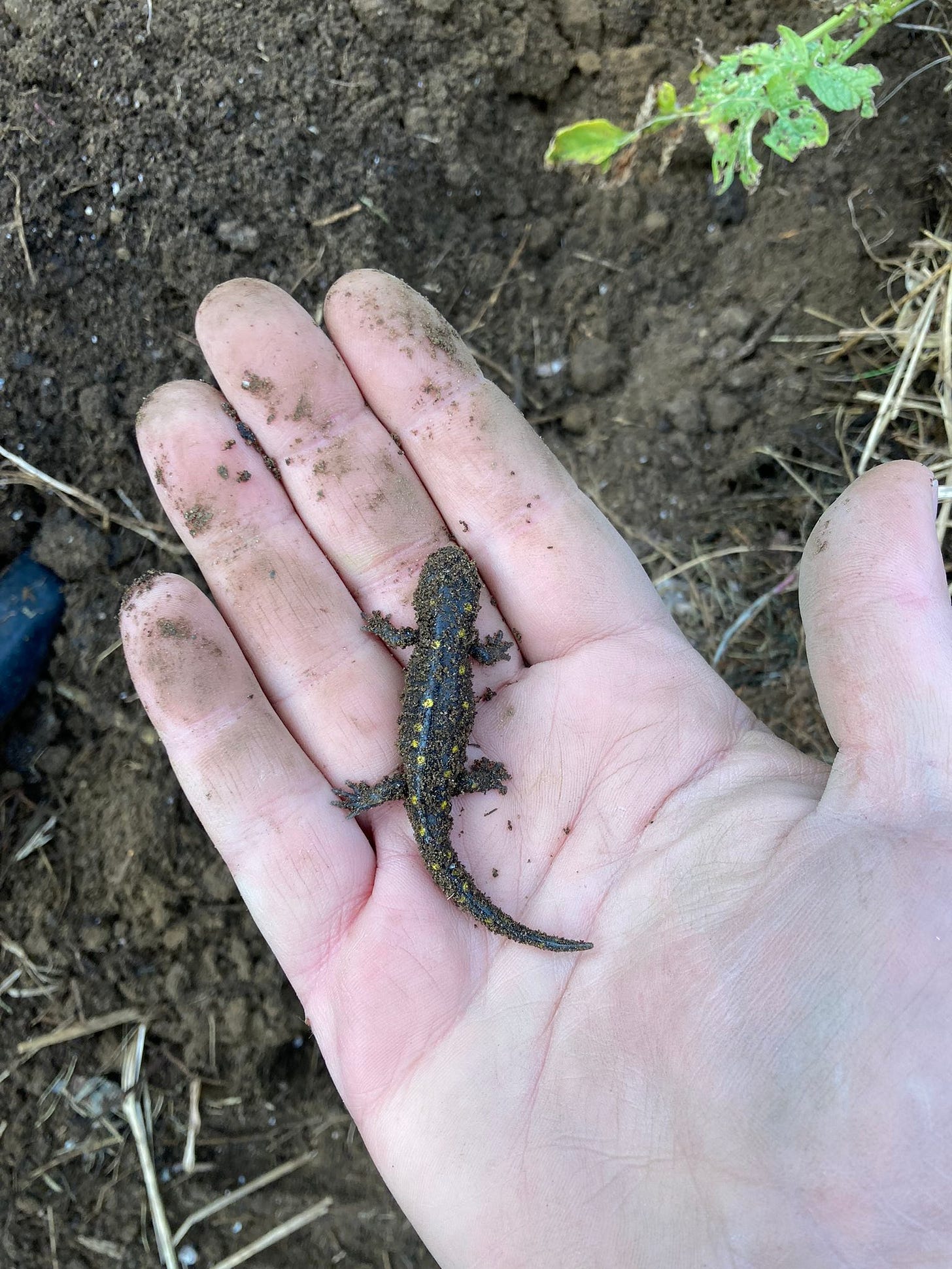There’s a wonderful kind of stoner logic to growing potatoes: you take little pieces of other potatoes, bury them in the earth, and then come back months later to dig up many more potatoes. It’s like something out of a myth, or one of those click-bait Instagram videos that suggests you can grow strawberries or kiwis by simply burying a piece of fruit (spoiler alert: you cannot). But with potatoes it’s true: one little piece of spud really will begat many more.
I grew potatoes for the first time in Los Angeles, and I thought I came up with a genius scheme: I’d plant a little row, and instead of waiting for the potatoes to mature and digging the plants up entirely, and I’d just rouse around in the loose dirt for baby potatoes whenever I wanted them. At the time, that’s the only kind of potato I ever ate, and the kind of potato that California had habituated me into wanting: tiny, colorful, tender. Freshly dug new potatoes were always available in massive piles at the farmers market, with skins so undeveloped that they could almost be rubbed off with a push of your thumb, no need for a peeler (or peeling, for that matter). If there was seemingly only one potato when I was a kid — the drab, reliable russet — the farmer’s market and grocery stores, full of little string bags of various pee-wee-type potatoes, were showing off the incredible variety that Solanum tuberosum has to offer. But while history has shown that growing lots of different potato varieties is not just a good idea but imperative (British colonialism was the root cause of the Irish potato famine, but the fact that there was only one type of potato being grown in Ireland in mid-1800s is partly why the blight was able to cause such an extensive crop failure), the potatoes turn as a fresh vegetable neglects what is arguably it’s greatest attribute: potatoes are the ultimate storage crop.
I only remember pulling a few baby fingerlings from underneath my new-potato-only plot, which I gave up on after finding that the precious little potatoes often tasted bitter (which I’ve come across a few times with homegrown potatoes, and I honestly do not understand the reason why). My experience of growing them for storage in Maine, however, has been both more fruitful and delicious. Because the whole notion of fresh, new potatoes being superior is ultimately a scam: a thick-skinned storage potato can be delicious no matter how large it is or when it’s eaten. The flavor is determined less by freshness than by variety. A russet tastes like a russet — which is to say, like not much at all — because it is a russet. But there are countless varieties of potatoes, more than 1000 that are commonly grown, and many are far more flavorful. I personally prefer yellow-fleshed varieties — which is probably because of the Yukon Golds that started showing up at New Pioneer Co-Op in Iowa City when I was still in high school, giving me my first taste of a truly potato-y potato. I’ve grown them before, and the yields are great, but for the last few years I’ve gone with German Butterballs, which I prefer for a few reasons: they’re a late variety, dug closer to winter than early-maturing Yukon Golds, and are known for storing well. The yields are definitely lighter in my experience, but the Butterball flavor cannot be beat. They’re also an heirloom that you can sometimes buy at the grocery store, which is exactly how I started growing mine a few years ago. Buying actual seed potatoes, which are grown and selected to be planted, is supposedly a good idea, but I never want to spend the extra money per pound plus shipping when they’re ultimately just…potatoes. (I would however like to grow the Carola variety some day.)
Potatoes are relatives of tomatoes (both were first domesticated in the Andes by the Inca), a relationship that’s very apparent in the garden: the plants are “vines” in the same sense that tomatoes are, and left unchecked they will flop and sprawl all over the place. Hilling potatoes — piling up dirt or mulch or seaweed or straw or whatever, really — around the base of the plants keeps them tidy, and lengthens the underground portion of the plant where new potatoes can develop. And that’s probably the most difficult thing about tending to them: all of the action is taking place under that hill, completely out of sight. With tap root crops — carrots and radishes and turnips and the likes — you can almost always see the shoulders of the vegetable sticking up above the soil, offering at least a hint of what’s going on underground. But with tubers, you can’t see anything, making potatoes a test of faith and patience.
But the plants themselves are surprisingly pretty, especially when they’re covered with nodding little blossoms; Butterballs have white flowers, but depending on the variety the color can range from violet to purple. The fruit, which like any above-ground part of the plant is extremely poisonous, looks a bit like a green tomato, and is pretty inconspicuous.
Digging potatoes feels a bit like a treasure hunt, since the tubers can sometimes be found far from the plant itself, connected by only the slightest thread of a root. It’s a thrill to finally get under the hilled-up plants after all those months of waiting, and once I’ve pulled up the main clump of tubers that grows around the seed potato I always carefully sift through the cold dirt, digging down and around toward the edges of the hill, to make sure that I find every last one. With late potatoes digging is fall garden work, and the cooler weather makes it feel even more imperative to get everything that I can out of the garden, to not leave any spuds behind.
Like most storage crops, potatoes are cured in order to help them last for as long as possible. A stint sitting in a warm, dry place helps toughen up the skins — which means that any dirt clinging to the freshly dug potatoes is only brushed off, never washed. So now, when I reach into my potato basket to pull out a few Butterballs, I can still feel the dust-like coating of Gurney Hill soil that still clings to each one. In past winters, it felt like a reminder of the next garden season to come; now, with the house sold, feeling that dirt on my fingertips is another way for me to get every last bit out of that garden, to make it last as long as I can.
Boiled Potatoes with Butter
I found a potato ricer on someone’s stoop a few weeks back, which felt like a sign that I should work up a gnocchi recipe for you. If you do want to make gnocchi at home, you absolutely need a ricer, which is key to making dumplings that will hold together while still remaining nice and pillowy. But when I was cooking potatoes (baked, skins on, so as to not add any additional water) for gnocchi the other day, I did what I almost always do when baking or boiling potatoes: I cut one too-hot potato in half, dotted it with a bit of butter, sprinkled it with salt, and ate it with my fingers before the pat could completely melt away. If you have good, flavorful potatoes that’s truly the best way to eat them, and it doesn’t have to be limited to a cook’s treat.
Good potatoes
Good butter
Good salt
In a saucepan, cover whole potatoes with water, season heavily with salt (not the good stuff), and bring to a boil over medium-high heat. Quickly reduce to a gentle simmer, so as not to cause the skins to spit, and cook until completely tender. Drain the potatoes, and set aside to cool until they can be handled. Split lengthwise, and dot the cut side with a generous amount of butter and a hearty pinch of flaky salt. Eat immediately.




